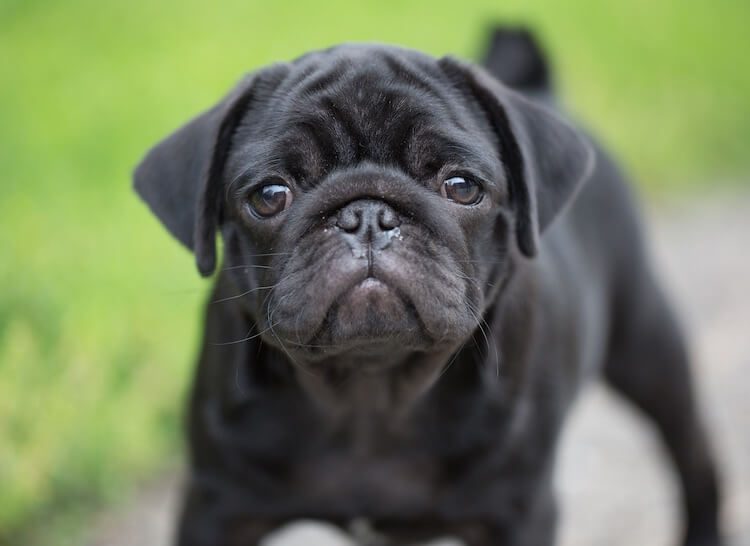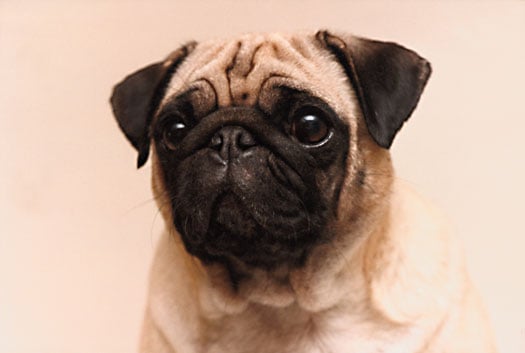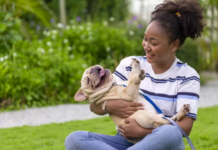Last Updated on August 26, 2021 by Fumipets
We can’t deny that the topic of dog coat colour and the genetics behind all of the many colours, tints, patterns, and combinations may be rather complicated.
When you compare the conventional colours for a breed to the colours that are really available, you’ll frequently find yourself scratching your head, even more confused than before.
What about the charming, wonderfully adorable Pug, America’s 28th most popular breed? Pugs come in three colours, according to the American Kennel Club (AKC) description: Silver, Apricot-Fawn, and Black.
If you look carefully at the AKC’s official breed standard, you’ll see that only fawn and black are mentioned.
Do you see what we mean when we say scratching your head?
Pugs come in a variety of colours. While numerous colours, such as Blue, Chocolate, and White, as well as patterns such as Merle, Brindle, and Pied, are available, the AKC only accepts Fawn and Black in the show ring. The Fawn colour comes in a variety of shades, ranging from light cream to apricot.
Let’s take a deeper look at the many popular Pug colours and shades, as well as the less frequent (unusual) variants available today.

Most Common Pug Colors
Before we look at the most prevalent colours seen in today’s Pugs, we’d want to explain the AKC’s position on Pug colour.
AKC Breed Standard
Only two colours, fawn and black, are permitted in the AKC show ring. Any other colour is considered disqualified. While black is black, fawn comes in a variety of tints and colours ranging from light to medium cream.
Pugs that are really silver or apricot (both of which may seem very close to pure fawn depending on the shade) can be registered as fawn and therefore compete, or they can be classified as an alternate colour, which would reveal their true colour but would be a show ring disqualification.
So, although the AKC only allows two colours in the show ring, it allows both silver and apricot-fawn Pugs to be registered as fawn Pugs.
Other Clubs’ Breed Standards
There are four Pug colours recognised by the Fédération Cynologique International (FCI), often known as the World Canine Organization: fawn, black, silver, and apricot. The Kennel Club of the United Kingdom (KC) follows suit.
Only fawn, including light and dark tints, silver-fawn, and black, is permitted by the Canadian Kennel Club (CKC).
Fawn

The colour fawn is found in nearly two-thirds of all Pugs. The fawn colour may be anything from a light cream to a medium cream to different colours of gold, or it might be a cream base with silver overtones. This most popular colour may have traces of very faint orange or even tiny shades of red, but a rich cream colour is preferred.
While many fawn Pugs are largely the same colour throughout, others may have a mix of fawn colours on their body, with some parts being considerably lighter or darker than others.
Black

Black Pugs should have a consistent, thick black coat all over. On rare occasions, a little white marking on the chest may appear, and even more rarely, one or more of the paws will be white.
This is a significant flaw in the show ring and is caused by the presence of a parti-factor gene. This white colouring may occur in any coat colour, but black Pugs have a particularly striking white colouration.
Because black is a dominant colour, pugs with two black colour genes seem to have a rich, bluish-black hue in sunlight and will always birth black pups.
Pugs with one black colour gene and one fawn colour gene are also black, but their coats have a rusty or brown shine in the sunlight. Depending on whatever colour genes their partner contributes, they may produce either fawn or black pups.
Silver And Silver-Fawn

Silver, as you would imagine, is a precious metal. Pugs have a beautiful grey shine to their coats, which range in colour from mild to dark. The silver-fawn colour is a variant of fawn that is extremely pale. If the dog is eligible to be registered and the owner chooses to do so, both colours may be registered as fawn.
Apricot And Apricot-Fawn

Apricot is a darker shade of orange than fawn. A Pug that is halfway between a light fawn and a rich apricot may be classified as an apricot-fawn at the discretion of the owner. Apricot Pugs often have a lighter patch on the chest or elsewhere on the body, especially above the face mask.
An apricot or apricot-fawn may be registered as a fawn or as an alternate colour by owners of an AKC-registrable Pug.
Special Markings
Mask And Ears
/stickers-head-pug-puppy-closeup-isolated-on-white-background.jpg.jpg)
A thick black face mask should be worn by all non-black Pugs, starting under the chin, covering the snout, and reaching over the eyes. Ears should also be black.
Thumbprint

A dark thumbprint (darkened area of pigment) on the forehead and a dark trace (line of darker colour on the back) are very desired characteristics, although not all Pugs have them. All markings should be as dark and vivid as possible, according to the AKC.
Smuttiness

Smuttiness is a trait that certain Pugs exhibit. In this case, the word refers to a disproportionate amount of black hairs interspersed with coats of lighter colours.
Scattered black hairs on a light-coloured dog are natural and do not qualify as smuttiness, but if the coat seems to be a different colour, the dog is considered to have smuttiness.
In the show ring, smuttiness is considered a flaw, and points will be removed from the final score. However, it is not a disqualification.
Rare Pug Colors
If you take the time to go over the websites of a few Pug breeders, you’ll almost certainly come across some colours that haven’t previously been linked with Pugs. Here are a few you’re likely to come across:
- White
- Brindle
- Blue
- Blue-Fawn
- Merle
- Blue-Merle
- Chocolate
- Panda
- Black and Tan
- Pink
- Chinchilla
- Pied
- Platinum
While the newer, often flashier colours are attractive, bear in mind that they are not in the lineage of a purebred Pug. A new breed was introduced to the mix at some point in order to create these colours.
A genetic test would confirm that these different coloured Pugs are not purebred.
Breeders selling unusually coloured Pugs are actively, purposefully breeding away from breed standards, which may result in the loss of certain conventional Pug traits. If you’re searching for a high-quality, purebred Pug that looks just like a Pug, keep all of this in mind.
Does the colour of a pug change as it gets older?
It’s very unusual for a non-black Pug’s coat colour to lighten or deepen as they get older, particularly during the first year. The apricot colour may not appear at birth, but it will emerge as the puppy develops.
The level of smuttiness varies with time, either going away or deepening. As the puppy grows older, the black on the face mask and ears may become more prominent. A dark trace may brighten or grow more apparent with time.
Grey hairs, particularly around the muzzle, are common in black Pugs as they become older.

Related Questions
Does Pug Coat Color Affect Temperament?
While some individuals believe their black Pug is more active and engaging than their fawn Pug, their views are based only on the personality of their dogs, not the colour of their coat. A genetic connection between coat colour and temperament has yet to be discovered.
Does Pug Coat Color Affect Shedding?
No. The colour of a dog’s coat has no bearing on his or her shedding habits. Shedding is a breed-specific characteristic that is not colour-dependent. The majority of Pugs have a double coat that sheds seldom.
Some black Pugs, on the other hand, only have one coat. A single coat will not lose as much hair as a double coat. As a result, shedding levels are determined by coat type rather than colour.


















